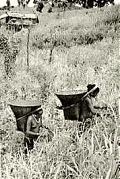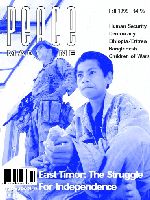Peace in the Hills
An uneasy peace came to the Chittagong Hill Tracts (CHT) region of Bangladesh in December 1997 with the signing of a peace accord between the government and guerrillas who had been waging a low-intensity insurgency for 25 years.

A peace accord in the hills of Bangladesh illustrates the connection to human security. The insurgency ended, but true peace requires democracy, which is not in place.
Although the CHT region takes up 10 per cent of the land mass of Bangladesh, it is the most sparsely populated area in the crowded country. Most residents of this dense, hilly jungle region are indigenous people of Sino-Tibetan descent, many of them Buddhist (though most people in Bangladesh are Bengali Muslims), and commonly known as the hill peoples. For centuries they eked out a living based on a variation on the slash-and-burn farming, retaining considerable autonomy until Bangladesh gained independence from Pakistan in 1971.
Tensions increased in the region when the government began a resettlement program to ease the burgeoning land pressure in the rest of Bangladesh. The hill peoples often lost land through violence and were forced to assimilate. Ultimately clashes with the government escalated to massacres and the displacement of populations, which continued until the peace accord was signed. Now there is formal peace in the region, but any one of the many pressure points could close down the peace process.
Among both Bengali settlers and indigenous hill peoples, many are opposed to the peace process because they feel too much was signed away with the agreement. The hill peoples are demanding: (a) constitutional recognition of the ethnic minorities of the CHT; (b) guarantees of full autonomy for the region; (c) the restoration of land rights for the indigenous peoples; (d) withdrawal of the military from the region; and (e) the resettlement of the Bengali settlers to the plains.
Many Bengali settlers claim that they will become a disenfranchised minority group if the accord is implemented as it now stands, since Chair of the new Regional Council will always be an indigenous person, and that the accord does not call for the protection of the linguistic and cultural rights of the settlers, although it does for the hill peoples.
The split in the indigenous community between those opposing and those favoring the accord has only exacerbated the difficulties. Those opposed are becoming stronger; large demonstrations took place against the accord in May.
A struggle for power has divided the indigenous community. The smaller indigenous groups feel unrepresented and thus resent the fact that the Shanti Bahini are in charge of implementing the peace agreement. That group is the political wing of the indigenous guerrilla movement. Up to 11 different indigenous hill groups in the CHT are struggling for their ethnic existence, alongside the dominant Chakma tribe. Thus these smaller tribes worry that the emphasis on "indigenous nationalism" by the JSS, the political wing of the local peace force, is actually Chakma chauvinism.
The Bangladesh National Party (BNP), the main opposition to the ruling party, the Awami League, is widely seen as fanning the flames of anti-peace accord sentiment and encouraging factional fighting. The BNP has declared they will annul the agreement if they regain political leadership.
Land remains the sticking point
The issue of land remains the sticking point for the peace process. Indigenous hill groups claim the government is delaying resolving the disputes that have already arisen. Although the agreement restores tribal property rights, the Land Commission will be hard-pressed to settle land disputes in this way. For example, much of the land cultivated by the indigenous population never had formal ownership. Thus, in the absence of formal documentation, the indigenous may be unable to contest rights to land they had previously occupied and cultivated. There could be a conflict between customary law and codified land administration regulations.
What will happen to those displaced by the settlement of land disputes? The agreement does not provide for rehabilitation of those whose claims are ultimately unsuccessful and who must vacate their land and resettle. This will only heighten tensions between Bengali settlers and indigenous residents.
The Bengali settlers are already feeling abandoned by the government. They fear the loss of their constitutional rights and their guarantees of land. In their "siege mentality," many of the settlers live in cluster villages close to "temporary" military bases. Withdrawal by the army will only increase the settlers' sense of vulnerability and their hostility towards the hill peoples. One marginalized group, the Bengali settlers who represent the poorest of the poor in Bangladesh, are being pitted against another marginalized group, the indigenous peoples.
Indigenous groups distinguish between those they consider "political" settlers (i.e., those whom the government resettled in the region in the '70s and '80s with generous resettlement packages, which constitute the majority of Bengalis currently residing in the region) and "natural" settlers, those Bengalis who lived in the region prior to the resettlement programs. The agreement allows for all currently living in the CHT [indigenous and Bengali alike] the right to residence in the region, but the "political" settlers will be a point of contention.
The accord also remains silent concerning internally displaced persons (IDPs). They constitute the largest number within the indigenous population - around 100,000. These people were displaced by the government resettlement programs, military actions and human rights violations, and the building of a dam. Many of them have integrated into neighbouring villages, towns and, in some instances, countries. However, the majority of them want to be rehabilitated to their original place of residence. Com-pensation will obviously fall under the mandate of the Land Commission, and the issue may take years to unravel. In the meantime, many of the IDPs continue to live in remote makeshift settlements where there are few basic services. There has been compensation to those indigenous families who left for India during the strife. However, the question remains: how many of these returnees are still landless? The JSS claims there are 3,000 outstanding disputes, while the government claims the number is only about 400.
Another sticking point is the issue of the Constitution. The ruling party probably will never be able to pull together the two-thirds majority needed to amend the Constitution. The ruling party may not enshrine indigenous group rights in the constitution. However, by framing the accord under parliamentary law rather than constitutional law, any government with a simple majority can repeal any of these laws. Thus the peace agreement cannot be ensured over the long term. The issue of impunity is also not addressed. There has been no reform of or within army personnel. Those responsible for human rights violations are still in positions of authority.
However, the major source of mutual distrust is that there is almost no reconciliation between the indigenous peoples and the Bengali settlers. To ensure a truly sustainable peace, the animosity that was built up over two decades of insurgency, human rights violations, displacement, and militarization needs to be overcome.
The peace accord can be interpreted as providing the government with the ultimate authority on all decisions of the Regional Council. Certainly if the Council's decisions and activities directly contravened the policies of the government, they would no doubt exercise their option to give the Council "instructive orders."
The process of rehabilitation after the signing of a peace agreement is not just a matter of technical arrangements, but one that depends on a parallel political, social and economic reconstruction. Successful peace building requires the affected communities to feel as an integral part of, and to benefit from, the reconstruction and development of the area. High expectations have been born with the signing of the peace accord. If expectations are not met, then unrest and frustration with the peace agreement will increase.
Corey Levine was on mission in Bangladesh, and is now in Kosovo with the OSCE.
